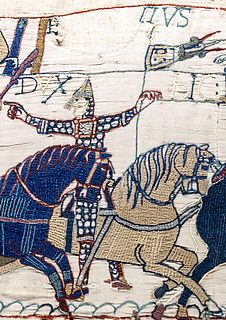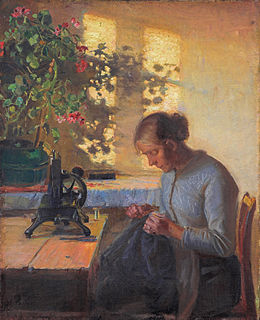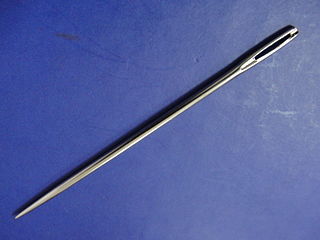Related Research Articles

Embroidery is the craft of decorating fabric or other materials using a needle to apply thread or yarn. Embroidery may also incorporate other materials such as pearls, beads, quills, and sequins. In modern days, embroidery is usually seen on caps, hats, coats, overlays, blankets, dress shirts, denim, dresses, stockings, and golf shirts. Embroidery is available in a wide variety of thread or yarn colour.

A sewing machine is a machine used to sew fabric and materials together with thread. Sewing machines were invented during the first Industrial Revolution to decrease the amount of manual sewing work performed in clothing companies. Since the invention of the first sewing machine, generally considered to have been the work of Englishman Thomas Saint in 1790, the sewing machine has greatly improved the efficiency and productivity of the clothing industry.

Sewing is the craft of fastening or attaching objects using stitches made with a sewing needle and thread. Sewing is one of the oldest of the textile arts, arising in the Paleolithic era. Before the invention of spinning yarn or weaving fabric, archaeologists believe Stone Age people across Europe and Asia sewed fur and leather clothing using bone, antler or ivory sewing-needles and "thread" made of various animal body parts including sinew, catgut, and veins.

A tailor is a person who makes or alters clothing, particularly in men's clothing. The Oxford English Dictionary dates the term to the thirteenth century.

A sewing needle, used for hand-sewing, is a long slender tool with a pointed tip at one end and a hole to hold the sewing thread. The earliest needles were made of bone or wood; modern needles are manufactured from high carbon steel wire and are nickel- or 18K gold-plated for corrosion resistance. High quality embroidery needles are plated with two-thirds platinum and one-third titanium alloy. Traditionally, needles have been kept in needle books or needlecases which have become objects of adornment. Sewing needles may also be kept in an étui, a small box that held needles and other items such as scissors, pencils and tweezers.
Gregorio Cortez Lira was born in the state of Tamaulipas, Mexico on June 22, 1875 and became a folk hero to the border communities of the United States and Mexico. After an altercation in which he killed Sheriff W. T. (Brack) Morris, Cortez went on the run from the Texas Rangers for thirteen days. He became the target of the largest manhunt in U.S. history from June 14, 1901 to June 22, 1901. He was accused of murdering two sheriffs and finally convicted of horse theft.

"The Brave Little Tailor" or "The Valiant Little Tailor" or "The Gallant Tailor" is a German fairy tale collected by the Brothers Grimm. "The Brave Little Tailor" is a story of Aarne–Thompson Type 1640, with individual episodes classified in other story types.

"The Clever Little Tailor" is a German fairy tale collected by the Brothers Grimm as tale 114. It is Aarne-Thompson type 850, The Princess's Birthmarks. Andrew Lang included it in The Green Fairy Book.
"The Four Skillful Brothers" is a German fairy tale collected by the Brothers Grimm. It is Aarne-Thompson type 653.
Chicano literature, or Mexican-American literature, refers to literature written by Chicanos in the United States. Although its origins can be traced back to the sixteenth century, the bulk of Chicano literature dates from after the 1848 United States annexation of large parts of Mexico in the wake of the Mexican–American War. Today, this genre includes a vibrant and diverse set of narratives, prompting critics to describe it as providing "a new awareness of the historical and cultural independence of both northern and southern American hemispheres".

The straight or running stitch is the basic stitch in hand-sewing and embroidery, on which all other forms of sewing are based. The stitch is worked by passing the needle in and out of the fabric at a regular distance. All other stitches are created by varying the straight stitch in length, spacing, and direction.

Américo Paredes was an American author born in Brownsville, Texas who authored several texts focusing on the border life that existed between the United States and Mexico, particularly around the Rio Grande region of South Texas. His family on his father’s side, however, had been in the Americas since 1580. His ancestors were sefarditas, or Spanish Jews who had been converted to Christianity, and in 1749—along with José de Escandón—they settled in the lower Rio Grande. The year of Paredes’ birth was the year of the last Texas Mexican Uprising, which was to portend the life Paredes was to lead. Throughout his long career as a journalist, folklorist and professor, Paredes was to bring focus to his Mexican American heritage, and the beauty of those traditions.

In the textile arts, a stitch is a single turn or loop of thread, or yarn. Stitches are the fundamental elements of sewing, knitting, embroidery, crochet, and needle lace-making, whether by hand or machine. A variety of stitches, each with one or more names, are used for specific purposes.
Sewing is the craft of fastening or attaching objects using stitches made with needle and thread. Sewing is one of the oldest of the textile arts, arising in the Paleolithic Era. Although usually associated with clothing and household linens, sewing is used in a variety of crafts and industries, including shoemaking, upholstery, sailmaking, bookbinding and the manufacturing of some kinds of sporting goods. Sewing is the fundamental process underlying a variety of textile arts and crafts, including embroidery, tapestry, quilting, appliqué and patchwork.
Thank God It Wasn't A Peso is a Mexican fairy tale collected by Americo Paredes in Ajusco, Mexico from J. F., a mestizo man in his fifties, and included by him in Folktales of Mexico. It is Aarne–Thompson type 1689, Thank God They Weren't Peaches.
God Gives a Hundred for One is a Mexican fairy tale collected by Virginia Rodriguez Rivera in Mexico, from Manuel Guevara, forty-nine. It is Aarne–Thompson type 1735 'Who gives his own goods shall receive it back tenfold'.
"The Greenish Bird" is a Mexican fairy tale collected by Joel Gomez in La Encantada, Texas from a seventy-four-year-old woman, Mrs. P.E.
The Bird Lover, also known as The Prince as Bird, is a type of narrative structure in folklore, no. 432 in the Aarne–Thompson classification system. In the typical version of story, a woman acquires a bird lover—a nobleman in the shape of a bird—who is wounded by means of a trap set by the woman's husband, such as a set of sharp points set up outside the woman's window. She follows the wounded bird's trail, cures him, and then marries him.
...y no se lo tragó la tierra is Tomás Rivera 1971 novel, most recently translated to English as ...And the Earth Did Not Devour Him. It is made up of fourteen short stories and thirteen vignettes. The novel presents stories that center around a community of South Texan Mexican American migrant farm workers during the late 1940s and early 1950s. The novel begins with the short story "A Lost Year", in which an unnamed male protagonist cannot seem to remember what occurred during the previous year. The stories and vignettes that follow are fragmented, lack chronology and lack consistency in characters. The last short story, "Under the House", ties all of these stories together by presenting them as the memories of the male protagonist, who seems to become empowered by the act of remembering. The novel won the Premio Quinto Sol prize for literature in 1970 and has since been adapted into a movie.
With His Pistol in His Hand is a book about Gregorio Cortez written by Américo Paredes. It was published by the University of Texas Press and first printed in 1958.
References
- 1 2 Americo Paredes, Folktales of Mexico, p223 ISBN 0-226-64571-1
- ↑ Americo Paredes, Folktales of Mexico, p148 ISBN 0-226-64571-1